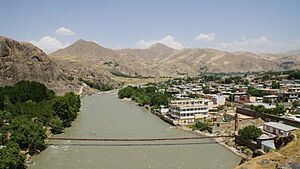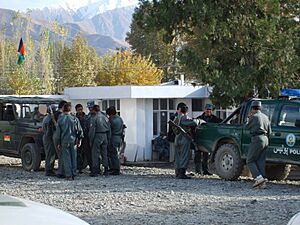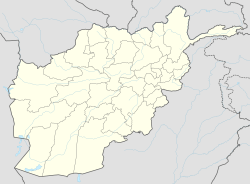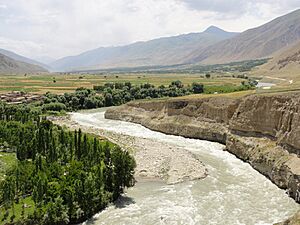Fayzabad, Badakhshan facts for kids
Quick facts for kids
Fayzabad
فيض آباد
|
|
|---|---|

The Kokcha River in Fayzabad
|
|
| Country | |
| Province | Badakhshan |
| District | Fayzabad |
| Area | |
| • Total | 7 km2 (3 sq mi) |
| Elevation | 1,254 m (4,114 ft) |
| Population
(2021)
|
|
| • Total | 39,555 |
| • Density | 5,700/km2 (14,600/sq mi) |
| Time zone | UTC+4:30 (AFT) |
Fayzabad (also spelled Feyzabad or Faizabad) is a city in northeastern Afghanistan. About 39,555 people live there. It is the capital and largest city of Badakhshan Province. Fayzabad is located in Fayzabad District. It sits high up, at about 1,254 meters (4,114 feet) above sea level.
Fayzabad is an important center for trade and government in the Pamir area. The Kokcha River flows right next to the city. There is also the Fayzabad Airport nearby, which offers some flights within Afghanistan.
Contents
History of Fayzabad
The city was once known as Jauz Gun until 1680. This was because many walnut ("jauz") farms grew in the area. Its name changed to Fayzabad, which means "abode of divine bounty, blessing, and charity." This happened when a special robe, believed to belong to Prophet Muhammed, was brought to the city.
This event made Fayzabad the capital of Badakhshan. Later, in 1768, Ahmad Shah Durrani moved the robe to Kandahar. He built the Mosque of the Cloak of the Prophet Mohammed there.
In 1821, the city was badly damaged. Many people moved away to Kunduz. But after it became part of Abdur Rahman Khan's rule, Fayzabad grew important again. It became a busy place for trade.
Many people used to visit a special shrine in the city. The Khoja community of Badakhshan took care of this shrine.
There are seven old forts in and around Fayzabad. Many of them are now in ruins. These forts were built to protect the city and its roads.
In 1979, Fayzabad became a place where Afghan groups tried to fight against the Soviet invasion. Soviet forces took over Fayzabad in 1980. They used it as a military base.
Today, many non-governmental organizations (NGOs) have their main offices in the newer parts of the city. These groups work to help people in Badakhshan province. Near the city, Germany led a Provincial Reconstruction Team (PRT). This team helped with rebuilding and security. Other countries like Denmark and the Czech Republic were also part of this team for some time. Their camp was built on an old Soviet airstrip.
On August 11, 2021, the city was taken over by the Taliban. This happened during a quick advance by the group in northern Afghanistan.
Geography of Fayzabad
The city is located on the right side of the Kokcha River. It sits near where the river leaves a narrow valley. After this, the river flows into a wide, open plain.
Climate in Fayzabad
Fayzabad has a climate with hot, dry summers and cold, somewhat wet winters. Most of the rain and snow falls in spring and winter.
| Climate data for Faiz abad (normals and extremes 1964-1983) | |||||||||||||
|---|---|---|---|---|---|---|---|---|---|---|---|---|---|
| Month | Jan | Feb | Mar | Apr | May | Jun | Jul | Aug | Sep | Oct | Nov | Dec | Year |
| Record high °C (°F) | 19.6 (67.3) |
20.5 (68.9) |
28.0 (82.4) |
33.2 (91.8) |
37.5 (99.5) |
41.4 (106.5) |
42.6 (108.7) |
41.2 (106.2) |
36.8 (98.2) |
34.2 (93.6) |
29.0 (84.2) |
21.4 (70.5) |
42.6 (108.7) |
| Mean daily maximum °C (°F) | 6.0 (42.8) |
8.2 (46.8) |
14.3 (57.7) |
21.3 (70.3) |
25.1 (77.2) |
31.6 (88.9) |
35.7 (96.3) |
34.9 (94.8) |
29.9 (85.8) |
23.1 (73.6) |
15.9 (60.6) |
9.7 (49.5) |
21.3 (70.4) |
| Daily mean °C (°F) | −0.1 (31.8) |
2.0 (35.6) |
7.7 (45.9) |
14.1 (57.4) |
17.6 (63.7) |
23.7 (74.7) |
27.1 (80.8) |
25.7 (78.3) |
20.3 (68.5) |
14.2 (57.6) |
7.5 (45.5) |
2.7 (36.9) |
13.5 (56.4) |
| Mean daily minimum °C (°F) | −4.3 (24.3) |
−1.2 (29.8) |
2.4 (36.3) |
8.0 (46.4) |
10.6 (51.1) |
13.9 (57.0) |
16.8 (62.2) |
15.5 (59.9) |
10.3 (50.5) |
6.3 (43.3) |
1.5 (34.7) |
−1.9 (28.6) |
6.5 (43.7) |
| Record low °C (°F) | −23.5 (−10.3) |
−24.5 (−12.1) |
−10.5 (13.1) |
−4.0 (24.8) |
1.1 (34.0) |
6.6 (43.9) |
9.0 (48.2) |
8.0 (46.4) |
2.0 (35.6) |
−2.9 (26.8) |
−8.8 (16.2) |
−17.2 (1.0) |
−24.5 (−12.1) |
| Average precipitation mm (inches) | 49.4 (1.94) |
65.0 (2.56) |
91.9 (3.62) |
97.9 (3.85) |
77.0 (3.03) |
8.2 (0.32) |
5.8 (0.23) |
1.0 (0.04) |
1.5 (0.06) |
23.4 (0.92) |
29.7 (1.17) |
34.1 (1.34) |
484.9 (19.08) |
| Average rainy days | 3 | 6 | 11 | 14 | 12 | 4 | 2 | 0 | 1 | 4 | 4 | 4 | 65 |
| Average snowy days | 9 | 7 | 3 | 0 | 0 | 0 | 0 | 0 | 0 | 0 | 1 | 4 | 24 |
| Average relative humidity (%) | 79 | 76 | 71 | 67 | 61 | 43 | 30 | 28 | 33 | 46 | 64 | 72 | 56 |
| Mean monthly sunshine hours | 117.3 | 116.2 | 149.2 | 186.2 | 256.9 | 313.6 | 324.5 | 305.2 | 279.1 | 224.2 | 176.4 | 127.3 | 2,576.1 |
| Source: NCEI(precipitation and humidity 1961-1983) | |||||||||||||
Economy in Fayzabad
For a long time, Fayzabad was hard to reach. This was because there were no paved roads connecting it to other parts of Afghanistan. Now, the ring road of Afghanistan has reached Fayzabad. This road connects Fayzabad with Taloqan and Kunduz. The United States paid about $200 million for this road.
The city has two busy markets. Here, you can find many different goods for sale. These include cotton, salt, sugar, tea, and tools.
Farmers in the area grow crops like barley, wheat, and rice. There are also many gardens and fruit orchards. People have found some success looking for gold in the rivers. You can also find beryl, a valuable gem, and there is a salt mine nearby.
Fayzabad also has small businesses that make woolen goods. There are also mills that process flour and rice. The Shorabak power station is just outside the city. It provides 7.5 megawatts of electricity to Fayzabad.
People and Culture in Fayzabad

In 2021, Fayzabad had about 39,555 people living there. Most of the people are Tajiks. There are also smaller groups of Pashtuns, Pamiris, Uzbeks, Hazaras, and Turkmens.
People in the city speak many different languages. Eleven languages are spoken, including Dari, Wakhi, Munji, and Pashto.
Fayzabad has several important mosques and shrines. These places have a lot of history and cultural meaning.
Education in Fayzabad
Badakhshan University is located in Fayzabad. The city also has several public schools. This includes a school just for girls.
Public Services in Fayzabad
There is a hospital in the province that is run by the government. Fayzabad also has several private guesthouses. The Qasre Kokcha Hotel is one of the best. It offers good security, heating, electricity, and internet. There is also a guesthouse called Lapis Lazuli for people visiting from other countries.
See also
 In Spanish: Fayzābād para niños
In Spanish: Fayzābād para niños



